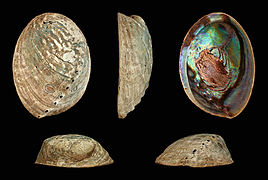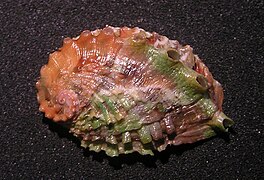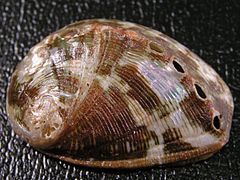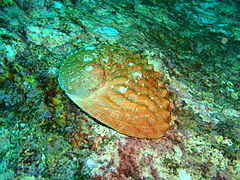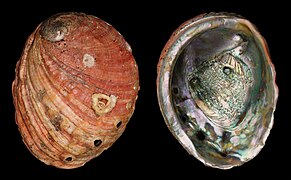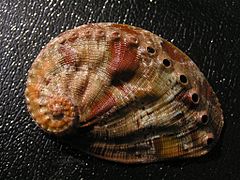
Abalone is a common name for any small to very large marine gastropod mollusc in the family Haliotidae, which once contained six genera but now contains only one genus, Haliotis. Other common names are ear shells, sea ears, and, now rarely, muttonfish or muttonshells in parts of Australia, ormer in the United Kingdom, perlemoen in South Africa, and pāua in New Zealand. The number of abalone species recognized worldwide ranges between 30 and 130 with over 230 species-level taxa described. The most comprehensive treatment of the family considers 56 species valid, with 18 additional subspecies.

Haliotis cracherodii, the black abalone, is a species of large edible sea snail, a marine gastropod mollusk in the family Haliotidae, the abalone.
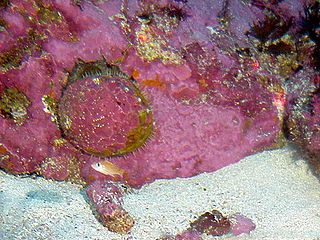
The white abalone, scientific name Haliotis sorenseni, is a species of large sea snail, a marine gastropod mollusk in the family Haliotidae, the abalone.

Haliotis australis, common name the queen pāua,yellowfoot pāua, or austral abalone, is a species of edible sea snail, a marine gastropod mollusk in the family Haliotidae, the abalone.
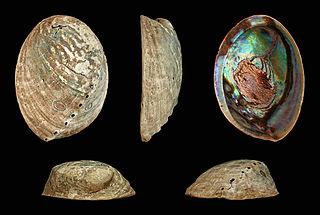
Haliotis iris, common name pāua, blackfoot pāua or rainbow abalone, is a species of edible sea snail, a marine gastropod mollusk in the family Haliotidae, the abalone.
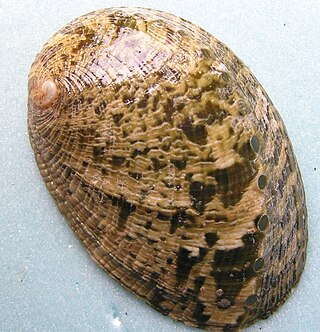
Haliotis virginea, Virgin pāua, is a species of edible sea snail, a marine gastropod mollusk in the family Haliotidae, the abalone.

Haliotis laevigata, common name the smooth Australian abalone or greenlip abalone or whitened ear shell, is a species of sea snail, a marine gastropod mollusk in the family Haliotidae, the abalone.

Haliotis kamtschatkana, common name the northern abalone, threaded abalone, or pinto abalone, is a species of large sea snail, a marine gastropod mollusc in the family Haliotidae, the abalone.

Haliotis asinina, common name the ass's-ear abalone, is a fairly large species of sea snail, a tropical gastropod mollusk in the family Haliotidae, the abalone, also known as ormers or pāua. Both the common name and the scientific name are based on the shape of the shell, which is long, narrow and curved, resembling the shape of a donkey's ear.
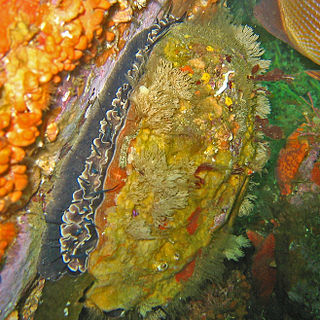
Haliotis rufescens is a species of very large edible sea snail in the family Haliotidae, the abalone, ormers (British) or pāua. It is distributed from British Columbia, Canada, to Baja California, Mexico. It is most common in the southern half of its range.

The green ormer is a northeast Atlantic and Mediterranean species of sea snail, a coastal marine gastropod mollusc in the family Haliotidae, the abalone or ormer snails.

The pink abalone, scientific name Haliotis corrugata, is a species of large edible sea snail, a marine gastropod mollusk in the family Haliotidae, the abalone.
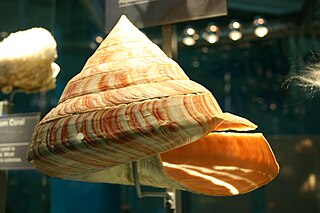
Pleurotomariacea is one of two names that are used for a taxonomic superfamily of sea snails that are an ancient lineage and are well represented in the fossil record. The name Pleurotomariacea is used by paleontologists, who, because they usually have only the hard parts of mollusks to study, often use a slightly different scheme of classification from that used by scientists who study living mollusks.

The blacklip abalone, Haliotis rubra, is an Australian species of large, edible sea snail, a marine gastropod mollusk in the family Haliotidae, the abalone.

Haliotis cyclobates, common name the whirling abalone or the circular ear shell, is a species of sea snail, a marine gastropod mollusk in the family Haliotidae, the abalone.

Haliotis fulgens, commonly called the green abalone, is a species of large sea snail, a marine gastropod mollusc in the family Haliotidae, the abalone. The shell of this species is usually brown, and is marked with many low, flat-topped ribs which run parallel to the five to seven open respiratory pores that are elevated above the shell's surface. The inside of the shell is an iridescent blue and green.

Haliotis scalaris, common name the staircase abalone or the ridged ear abalone, is a species of sea snail, a marine gastropod mollusk in the family Haliotidae, the abalone.

Haliotis stomatiaeformis is a species of sea snail, a marine gastropod mollusc in the family Haliotidae, the abalones. It is endemic to a small portion of the Mediterranean Sea, off the coasts of Sicily and Malta.

Haliotis parva, common name the canaliculate abalone, is a species of sea snail, a marine gastropod mollusk in the family Haliotidae, the abalone.

Haliotis varia, common name the variable abalone or the common ear shell, is a species of sea snail, a marine gastropod mollusk in the family Haliotidae, the abalones.






















